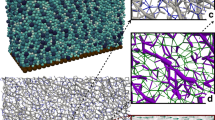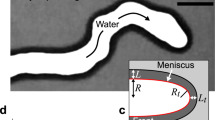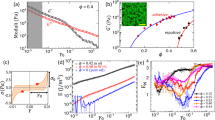Abstract
The interaction of intruding objects with deformable materials arises in many contexts, including locomotion in fluids and loose media, impact and penetration problems, and geospace applications. Despite the complex constitutive behaviour of granular media, forces on arbitrarily shaped granular intruders are observed to obey surprisingly simple, yet empirical ‘resistive force hypotheses’. The physics of this macroscale reduction, and how it might play out in other media, has however remained elusive. Here, we show that all resistive force hypotheses in grains arise from local frictional yielding, revealing a novel invariance within a class of plasticity models. This mechanical foundation, supported by numerical and experimental validations, leads to a general analytical criterion to determine which rheologies can obey resistive force hypotheses. We use it to explain why viscous fluids are observed to perform worse than grains, and to predict a new family of resistive-force-obeying materials: cohesive media such as pastes, gels and muds.
This is a preview of subscription content, access via your institution
Access options
Subscribe to this journal
Receive 12 print issues and online access
$259.00 per year
only $21.58 per issue
Buy this article
- Purchase on Springer Link
- Instant access to full article PDF
Prices may be subject to local taxes which are calculated during checkout





Similar content being viewed by others
Change history
11 October 2016
In the version of this Article originally published, an equation for the resistive force in cohesive media, located in the text between equations (6) and (7), should not have included a dependence of the constant yield stress, τy, within the function. This has been corrected in all versions of the Article.
References
Dickinson, M. H. et al. How animals move: an integrative view. Science 288, 100–106 (2000).
Vogel, S. Life in Moving Fluids: The Physical Biology of Flow (Princeton Univ. Press, 1996).
Lauder, G. V., Nauen, J. C. & Drucker, E. G. Experimental hydrodynamics and evolution: function of median fins in ray-finned fishes. Integr. Comp. Biol. 42, 1009–1017 (2002).
Wang, Z. J. Dissecting insect flight. Annu. Rev. Fluid Mech. 37, 183–210 (2005).
Li, C., Zhang, T. & Goldman, D. I. A terradynamics of legged locomotion on granular media. Science 339, 1408–1412 (2013).
Thorpe, S. K., Holder, R. & Crompton, R. Origin of human bipedalism as an adaptation for locomotion on flexible branches. Science 316, 1328–1331 (2007).
Biewener, A. A. Biomechanics of mammalian terrestrial locomotion. Science 250, 1097–1103 (1990).
Bhushan, B. Biomimetics: lessons from nature–an overview. Phil. Trans. R. Soc. A 367, 1445–1486 (2009).
Ma, K. Y., Chirarattananon, P., Fuller, S. B. & Wood, R. J. Controlled flight of a biologically inspired, insect-scale robot. Science 340, 603–607 (2013).
Williams, B. J., Anand, S. V., Rajagopalan, J. & Saif, M. T. A. A self-propelled biohybrid swimmer at low Reynolds number. Nat. Commun. 5 (2014).
Ijspeert, A. J., Crespi, A., Ryczko, D. & Cabelguen, J.-M. From swimming to walking with a salamander robot driven by a spinal cord model. Science 315, 1416–1420 (2007).
Maladen, R. D., Ding, Y., Li, C. & Goldman, D. I. Undulatory swimming in sand: subsurface locomotion of the sandfish lizard. Science 325, 314–318 (2009).
Bekker, M. G. Off-the-road locomotion: Research and Development in Terramechanics (Univ. Michigan Press, 1960).
Meirion-Griffith, G. & Spenko, M. Aerospace Conference, 2010 IEEE 1–6 (IEEE, 2010).
Johnson, L. & King, R. Measurement of force to excavate extraterrestrial regolith with a small bucket-wheel device. J. Terramechanics 47, 87–95 (2010).
Wong, J. Predicting the performances of rigid rover wheels on extraterrestrial surfaces based on test results obtained on earth. J. Terramechanics 49, 49–61 (2012).
Uehara, J., Ambroso, M., Ojha, R. & Durian, D. Low-speed impact craters in loose granular media. Phys. Rev. Lett. 90, 194301 (2003).
Shergold, O. A. & Fleck, N. A. Proceedings of the Royal Society of London A: Mathematical, Physical and Engineering Sciences Vol. 460, 3037–3058 (The Royal Society, 2004).
Gray, J. & Hancock, G. The propulsion of sea-urchin spermatozoa. J. Exp. Biol. 32, 802–814 (1955).
Lighthill, J. Mathematica Biofluiddynamics (SIAM, 1975).
Lauga, E. & Powers, T. R. The hydrodynamics of swimming microorganisms. Rep. Prog. Phys. 72, 096601 (2009).
Ding, Y., Gravish, N. & Goldman, D. I. Drag induced lift in granular media. Phys. Rev. Lett. 106, 028001 (2011).
Maladen, R. D., Ding, Y., Umbanhowar, P. B., Kamor, A. & Goldman, D. I. Mechanical models of sandfish locomotion reveal principles of high performance subsurface sand-swimming. J. R. Soc. Interface. 8, 1332–1345 (2011).
Rodenborn, B., Chen, C.-H., Swinney, H. L., Liu, B. & Zhang, H. Propulsion of microorganisms by a helical flagellum. Proc. Natl Acad. Sci. USA 110, E338–E347 (2013).
Schofield, A. N. & Wroth, C. P. Critical State Soil Mechanics (McGraw-Hill, 1968).
Kamrin, K. Nonlinear elasto-plastic model for dense granular flow. Int. J. Plast. 26, 167–188 (2010).
Kamrin, K. & Koval, G. Nonlocal constitutive relation for steady granular flow. Phys. Rev. Lett. 108, 178301 (2012).
Henann, D. L. & Kamrin, K. A predictive, size-dependent continuum model for dense granular flows. Proc. Natl Acad. Sci. USA 110, 6730–6735 (2013).
Chen, W.-F. Limit Analysis and Soil Plasticity (Elsevier, 2013).
Guillard, F., Forterre, Y. & Pouliquen, O. Depth-independent drag force induced by stirring in granular media. Phys. Rev. Lett. 110, 138303 (2013).
Brzinski III, T., Mayor, P. & Durian, D. Depth-dependent resistance of granular media to vertical penetration. Phys. Rev. Lett. 111, 168002 (2013).
Hill, R. New horizons in the mechanics of solids. J. Mech. Phys. Solids 5, 66–74 (1956).
Dassault Systèmes Simulia, Providence, RI Abaqus Reference Manuals 6. 11 edn (2011).
Goldman, D. I. Colloquium: Biophysical principles of undulatory self-propulsion in granular media. Rev. Mod. Phys. 86, 943–958 (2014).
Kinloch, I. A., Roberts, S. A. & Windle, A. H. A rheological study of concentrated aqueous nanotube dispersions. Polymer 43, 7483–7491 (2002).
Senff, L., Labrincha, J. A., Ferreira, V. M., Hotza, D. & Repette, W. L. Effect of nano-silica on rheology and fresh properties of cement pastes and mortars. Constr. Build. Mater. 23, 2487–2491 (2009).
Dzuy, N. Q. & Boger, D. V. Yield stress measurement for concentrated suspensions. J. Rheol. 27, 321–349 (1983).
Nedderman, R. M. Statics and Kinematics of Granular Materials (Cambridge Univ. Press, 2005).
Marvi, H. et al. Sidewinding with minimal slip: Snake and robot ascent of sandy slopes. Science 346, 224–229 (2014).
Adkins, C. N. & Liebeck, R. H. Design of optimum propellers. AIAA Paper 83–0190 (1983).
Acknowledgements
K.K. and H.A. gratefully acknowledge support from Army Research Office Grants W911NF-14-1-0205 and W911NF-15-1-0196.
Author information
Authors and Affiliations
Contributions
K.K. conceived the study and supervised the project. H.A. developed the computational routines and conducted the numerical modelling. K.K. and H.A. jointly performed the analysis and wrote the paper.
Corresponding author
Ethics declarations
Competing interests
The authors declare no competing financial interests.
Supplementary information
Supplementary Information
Supplementary Information (PDF 385 kb)
Supplementary Information
Supplementary Information (TXT 16 kb)
Rights and permissions
About this article
Cite this article
Askari, H., Kamrin, K. Intrusion rheology in grains and other flowable materials. Nature Mater 15, 1274–1279 (2016). https://doi.org/10.1038/nmat4727
Received:
Accepted:
Published:
Issue Date:
DOI: https://doi.org/10.1038/nmat4727
This article is cited by
-
Granular flow experiment using artificial gravity generator at International Space Station
npj Microgravity (2023)
-
Transport in a stochastic double diffusivity model
Meccanica (2023)
-
Measuring the mechanical properties of small body regolith layers using a granular penetrometer
Astrodynamics (2023)
-
Experimental studies on deformation of granular materials during orthogonal cutting
Granular Matter (2022)
-
A unified constitutive model for pressure sensitive shear flow transitions in moderate dense granular materials
Scientific Reports (2021)



